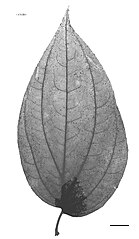Piper interruptum
| Piper interruptum | |
|---|---|

| |
| Scientific classification | |
| Kingdom: | Plantae |
| Clade: | Tracheophytes |
| Clade: | Angiosperms |
| Clade: | Magnoliids |
| Order: | Piperales |
| Family: | Piperaceae |
| Genus: | Piper |
| Species: | P. interruptum
|
| Binomial name | |
| Piper interruptum | |
| Synonyms[3] | |
Piper interruptum is a vine in the pepper family Piperaceae, native to the eastern parts of Southeast Asia and to Melanesia and Queensland.
Description
[edit]Piper interruptum is a root climber with a maximum stem diameter of 2 cm (0.79 in).[4] The leaves are ovate to narrowly ovate and mostly glabrous.[5] They measure up to 16 cm (6.3 in) long by 8.5 cm (3.3 in) wide, with a cuneate base which is often asymmetric, and an acuminate tip.[4][5] There are 1 to 3 pairs of lateral veins, all of which divert from the midvein in the basal portion of the leaf.[5] Petioles are 1 to 2 cm (0.39 to 0.79 in) long and stipules are 0.7 to 0.9 cm (0.28 to 0.35 in) long.[6]
This species is dioecious, meaning that pistillate (functionally female) and staminate (functionally male) flowers are borne on separate plants. The inflorescences are leaf-opposed, pendulous spikes, around 0.4 cm (0.16 in) wide on a peduncle 1 to 2 cm (0.39 to 0.79 in) long. The flowers are minute, just 0.5 mm (0.020 in) wide, and they lack both sepals and petals. Male spikes are 5 to 12 cm (2.0 to 4.7 in) long with the flowers densely clustered along its length, while female spikes are 7 to 19 cm (2.8 to 7.5 in) long and the flowers are arranged in two helical lines.[4][5][6]
The black fruit are, in botanical terms, berries around 4 mm (0.16 in) long and 5 mm (0.20 in) wide. They contain a single brown seed.[4][5][6]
Phenology
[edit]In Australia, flowering occurs from January to February,[6] and fruits ripen from June to August.[5][6]
Phytochemistry
[edit]The compounds crotepoxide, eupomatene and pipercallosine have been extracted from the stems of this plant.[7]
Taxonomy
[edit]This species was first described by the Czech-German botanist Philipp Maximilian Opiz in 1828, his description was published in volume 1 of Carl Borivoj Presl's book Reliquiae Haenkeanae, seu, Descriptiones et icones plantarum.[8]: 157
Etymology
[edit]The species epithet is from the Latin interruptus, meaning "broken apart" or "interrupted".[6] Opiz wrote in his description spadicibus cylindricus laxis, interruptis − "spadix cylindrical, lax, interrupted" − but it is unclear what he meant by the term.
Distribution and habitat
[edit]The distribution of this species is from Taiwan south to the Philippines, New Guinea, the Bismarck Archipelago, the Solomon Islands, Vanuatu and Queensland.[3] In Queensland it occurs on the northeast coast from Cape Tribulation south to Mackay in rainforest, monsoon forest and closed beach/coastal forest, often on soils derived from basalt. The altitude range is from sea level to about 800 m (2,600 ft).[4][5][6][9]
Conservation
[edit]This species is listed by the Queensland Department of Environment and Science as least concern.[1] As of 23 January 2024[update], it has not been assessed by the IUCN.
Uses
[edit]In parts of Asia this species has been used as an anti-flatulent, an emollient to relieve coughing and an antiseptic.[7]
Gallery
[edit]-
Foliage and flower spike
-
Foliage and flowers
-
Female flowers
-
Male flowers
-
X-ray of leaf
References
[edit]- ^ a b "Species profile—Piper interruptum". Queensland Department of Environment and Science. Queensland Government. 2022. Retrieved 9 March 2023.
- ^ "Piper interruptum". Australian Plant Name Index (APNI). Centre for Plant Biodiversity Research, Australian Government. Retrieved 9 March 2023.
- ^ a b c "Piper interruptum Opiz". Plants of the World Online. Royal Botanic Gardens, Kew. Retrieved 9 March 2023.
- ^ a b c d e F.A.Zich; B.P.M.Hyland; T.Whiffen; R.A.Kerrigan (2020). "Piper interruptum". Australian Tropical Rainforest Plants Edition 8 (RFK8). Centre for Australian National Biodiversity Research (CANBR), Australian Government. Retrieved 9 March 2023.
- ^ a b c d e f g Spokes, T.M. (2021). Busby, John R. (ed.). "Piper interruptum". Flora of Australia. Australian Biological Resources Study, Department of Climate Change, the Environment and Water: Canberra. Retrieved 9 March 2023.
- ^ a b c d e f g Cooper, Wendy; Cooper, William T. (June 2004). Fruits of the Australian Tropical Rainforest. Clifton Hill, Victoria, Australia: Nokomis Editions. p. 398. ISBN 9780958174213.
- ^ a b Thebpatiphat, S.; Pengprechaa, S.; Ternaib, B. (1988). "Some constituents of the stems of Piper interruptum Opiz". Journal of the Science Society of Thailand. 14: 225–231. doi:10.2306/scienceasia1513-1874.1988.14.225.
- ^ Presl, Carl Borivoj (1828). Reliquiae Haenkeanae, seu, Descriptiones et icones plantarum. Prague: J.G. Calve. Retrieved 10 March 2023.
- ^ "Search: species: Piper interruptum | Occurrence records | The Australasian Virtual Herbarium". Australasian Virtual Herbarium. Australian Government. Retrieved 10 March 2023.
External links
[edit] Data related to Piper interruptum at Wikispecies
Data related to Piper interruptum at Wikispecies Media related to Piper interruptum at Wikimedia Commons
Media related to Piper interruptum at Wikimedia Commons- View a map of historical sightings of this species at the Australasian Virtual Herbarium
- View observations of this species on iNaturalist
- View images of this species on Flickriver





